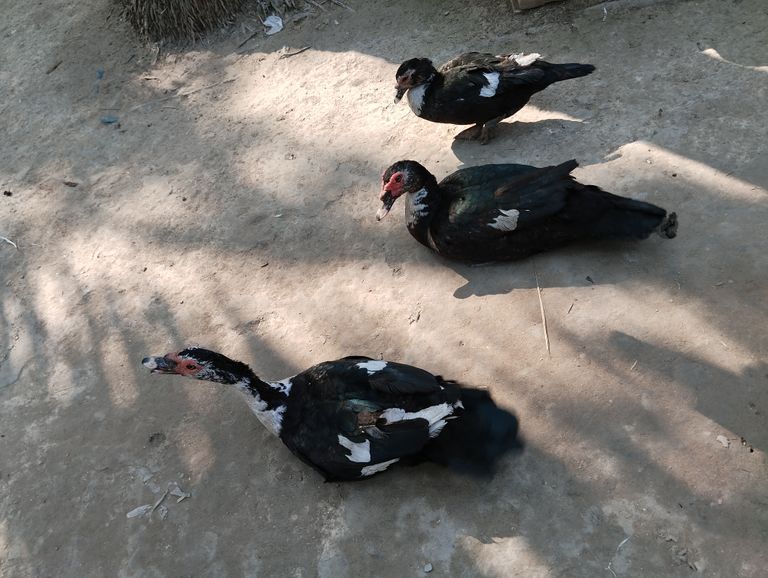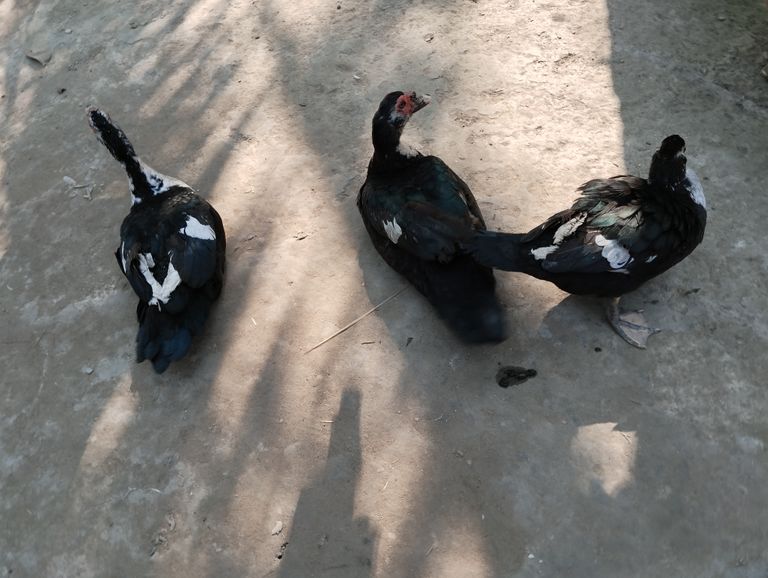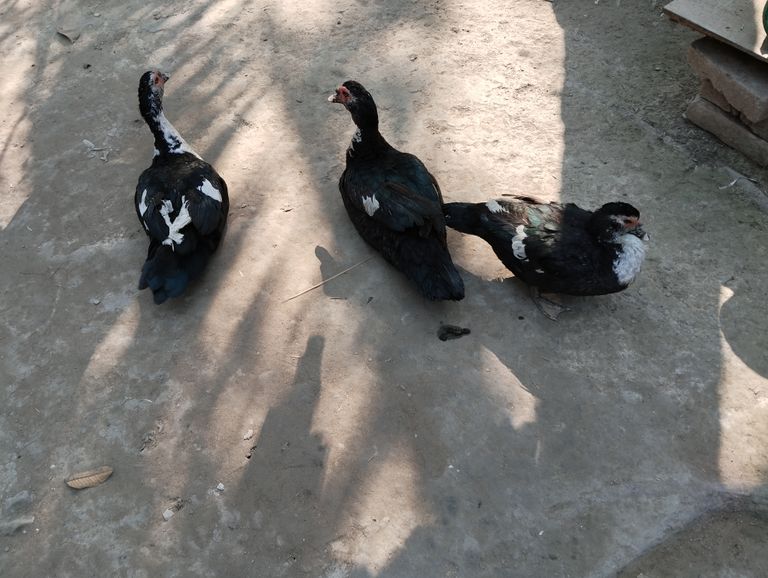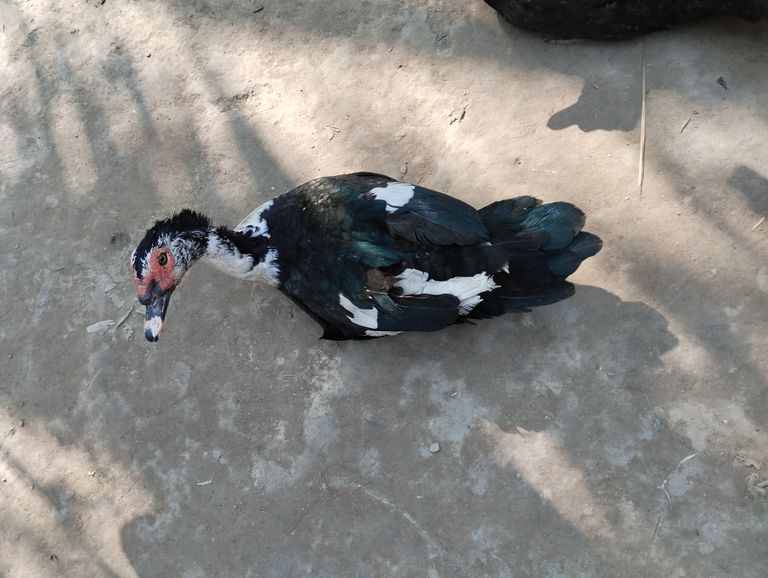
Raising Chinese Ducks A Complete Guide for Farmers.
Chinese duck farming is a profitable and sustainable business that provides meat, eggs, and manure for agricultural use. With proper care, feeding, and management, Chinese ducks can thrive in various climates and contribute significantly to a farmer’s income. This guide covers everything you need to know about raising Chinese ducks, including breed selection, housing, feeding, breeding, and health management.
- Understanding Chinese Duck Breeds
Chinese ducks are primarily divided into two types:
A. Pekin Ducks
One of the most popular breeds for meat production
Fast growth rate and high feed conversion efficiency
White feathers, orange beaks, and legs
Can weigh around 3-4 kg in 7-8 weeks
B. Shaoxing Ducks
Excellent for egg production, laying up to 250-300 eggs per year
Light brown or white feathers
Adapt well to free-range systems
C. Jinding Ducks
A crossbreed known for both meat and egg production
High adaptability to various climates
- Setting Up a Duck Farm
A. Housing Requirements
Ducks need well-ventilated, predator-proof housing with dry bedding.
Space Requirement: 4-5 ducks per square meter
Flooring: Use rice husk, straw, or sawdust for bedding
Ventilation: Ensure good airflow to reduce ammonia buildup
Protection: Install fencing to prevent attacks from predators
B. Water and Pond Management
Ducks need access to clean water for drinking and bathing.
Provide a shallow pond or water containers
Change the water regularly to maintain hygiene
Ducks should be allowed to swim daily for natural behavior
- Feeding Chinese Ducks
A balanced diet is essential for healthy growth and egg production.
A. Starter Feed (0-3 Weeks)
20-22% protein
Crushed grains, soybean meal, and vitamins
B. Grower Feed (4-8 Weeks)
16-18% protein
Corn, rice bran, fish meal, and greens
C. Layer Feed (After 8 Weeks for Egg Layers)
16-17% protein
Calcium supplements for strong eggshells
D. Natural and Supplemental Feeds
Vegetables, snails, earthworms, and aquatic plants
Commercial duck pellets for balanced nutrition
- Breeding and Incubation
A. Natural Breeding
Keep a ratio of 1 male to 5-6 females for effective fertilization
Ducks start laying eggs at 5-6 months of age
B. Egg Incubation
Natural incubation takes about 28 days
Maintain humidity and temperature (37-38°C) in incubators
Turn eggs several times daily for proper development
- Health Management and Disease Control
A. Common Diseases and Prevention
Duck Plague: Vaccinate young ducks at 3-4 weeks
Salmonellosis: Keep drinking water clean to prevent infection
Worm Infestation: Deworm ducks every 2-3 months
B. Biosecurity Measures
Quarantine new ducks before adding them to the flock
Clean and disinfect housing regularly
Avoid overcrowding to reduce disease risk
- Marketing and Profitability
A. Selling Ducks and Eggs
Sell live ducks to local markets or restaurants
Processed meat can fetch higher prices
Duck eggs are in high demand, especially salted or preserved
B. Value-Added Products
Duck manure can be sold as organic fertilizer
Feathers are used in pillow and bedding production
Raising Chinese ducks can be a profitable venture with proper planning and care. By selecting the right breed, maintaining good housing, providing balanced nutrition, and ensuring disease control, farmers can maximize their productivity and income. Whether for meat, eggs, or additional farm benefits, Chinese duck farming is a sustainable and rewarding business.

Building a Traditional Chinese-Inspired Tea House
A tea house is a tranquil space for relaxation, meditation, and enjoying tea with loved ones. If you're interested in building a Chinese-style tea house (চিনা আসার ঘর), this guide will help you design and construct a space that reflects traditional Chinese architecture while providing a peaceful retreat.
- Understanding Traditional Chinese Tea Houses
Chinese tea houses, known as 茶馆 (cháguǎn), are more than just buildings—they are symbols of culture, serenity, and hospitality. These structures often feature:
Curved roofs with upturned eaves
Wooden architecture with intricate carvings
Paper or silk screens for soft lighting
Feng Shui principles for harmony
A garden with water features and stones
By incorporating these elements, you can create a truly authentic tea house in your backyard, garden, or a special indoor space.
- Choosing the Perfect Location
To create a peaceful retreat, the location of your tea house is crucial. Consider:
A quiet corner of your garden away from noise
Near a pond or water feature to enhance serenity
Surrounded by bamboo, flowering plants, or bonsai for natural beauty
A spot with good sunlight and airflow for comfort
If building indoors, a dedicated room with large windows overlooking a garden can provide a similar experience.
- Design and Architectural Elements
A. Roof & Structure
Traditional Chinese roofs have curved, upturned eaves symbolizing good fortune.
Use wood, bamboo, and clay tiles to maintain authenticity.
A small pagoda-style roof adds a classic touch.
B. Walls and Doors
Use wooden panels with intricate carvings.
Consider shoji-style sliding doors with translucent paper or silk screens.
Red and gold accents can add a cultural feel.
C. Flooring
Wooden or stone flooring works best for an authentic feel.
Add woven mats or low wooden tables with cushions for seating.
- Interior Design & Decoration
A. Tea Table & Seating
Choose a low wooden tea table with floor cushions for an intimate experience.
For a more modern touch, use wooden chairs with silk cushions.
B. Lighting
Soft paper lanterns or hanging silk lamps create a warm ambiance.
Avoid harsh artificial lighting—use candles or dim LED lights.
C. Decorative Elements
Calligraphy scrolls with Chinese proverbs about tea and nature.
Porcelain tea sets with intricate blue-and-white designs.
Small bonsai trees, incense holders, and jade figurines.
- Creating a Zen Garden Around the Tea House
A Chinese tea house is often surrounded by a garden to enhance tranquility. Consider:
A stone pathway leading to the tea house
A koi pond or water fountain for a soothing sound
Bamboo and flowering plants like cherry blossoms
Rock formations to represent mountains in traditional Chinese landscaping
- Choosing the Right Tea for Your Tea House
A tea house isn't complete without high-quality Chinese teas. Some popular choices include:
Green Tea (Lóngjǐng / Dragon Well) – Refreshing & rich in antioxidants
Oolong Tea (Tieguanyin) – A fragrant, semi-fermented tea
Pu-erh Tea – Aged and fermented, known for its deep flavors
White Tea (Bái Chá) – Delicate, smooth, and lightly processed
Jasmine Tea – A floral, aromatic experience
Use traditional Chinese tea sets with small cups, a Gaiwan (lidded bowl), and a tea tray for proper serving.
- Feng Shui Tips for Harmony
To ensure your tea house has positive energy, follow these Feng Shui principles:
Face the entrance towards the east to welcome good energy.
Use natural materials like wood, stone, and clay.
Incorporate water elements (pond, fountain) to balance the environment.
Avoid sharp edges—opt for round tables and curved designs.
- Budget and Construction Tips
A. Estimated Budget
Basic DIY Tea House – $2,000 to $5,000
Professional Construction – $10,000+ (depending on materials)
B. Materials Needed
Wood & bamboo for the frame
Clay tiles for the roof
Stone or wooden flooring
Paper screens & silk decorations
C. DIY vs. Professional Help
DIY: Ideal for small-scale, low-budget projects.
Hiring professionals: Best for authentic, long-lasting structures.
Final Thoughts
Building a traditional Chinese tea house (চিনা আসার ঘর) is a rewarding project that brings peace, beauty, and cultural heritage into your space. Whether you prefer a simple wooden pavilion or a fully decorated pagoda-style retreat, this guide provides the essential steps to create a harmonious and authentic tea house experience.

Building a Traditional Chinese-Inspired Tea House
A tea house is a tranquil space for relaxation, meditation, and enjoying tea with loved ones. If you're interested in building a Chinese-style tea house (চিনা আসার ঘর), this guide will help you design and construct a space that reflects traditional Chinese architecture while providing a peaceful retreat.
- Understanding Traditional Chinese Tea Houses
Chinese tea houses, known as 茶馆 (cháguǎn), are more than just buildings—they are symbols of culture, serenity, and hospitality. These structures often feature:
Curved roofs with upturned eaves
Wooden architecture with intricate carvings
Paper or silk screens for soft lighting
Feng Shui principles for harmony
A garden with water features and stones
By incorporating these elements, you can create a truly authentic tea house in your backyard, garden, or a special indoor space.
- Choosing the Perfect Location
To create a peaceful retreat, the location of your tea house is crucial. Consider:
A quiet corner of your garden away from noise
Near a pond or water feature to enhance serenity
Surrounded by bamboo, flowering plants, or bonsai for natural beauty
A spot with good sunlight and airflow for comfort
If building indoors, a dedicated room with large windows overlooking a garden can provide a similar experience.
- Design and Architectural Elements
A. Roof & Structure
Traditional Chinese roofs have curved, upturned eaves symbolizing good fortune.
Use wood, bamboo, and clay tiles to maintain authenticity.
A small pagoda-style roof adds a classic touch.
B. Walls and Doors
Use wooden panels with intricate carvings.
Consider shoji-style sliding doors with translucent paper or silk screens.
Red and gold accents can add a cultural feel.
C. Flooring
Wooden or stone flooring works best for an authentic feel.
Add woven mats or low wooden tables with cushions for seating.
- Interior Design & Decoration
A. Tea Table & Seating
Choose a low wooden tea table with floor cushions for an intimate experience.
For a more modern touch, use wooden chairs with silk cushions.
B. Lighting
Soft paper lanterns or hanging silk lamps create a warm ambiance.
Avoid harsh artificial lighting—use candles or dim LED lights.
C. Decorative Elements
Calligraphy scrolls with Chinese proverbs about tea and nature.
Porcelain tea sets with intricate blue-and-white designs.
Small bonsai trees, incense holders, and jade figurines.
- Creating a Zen Garden Around the Tea House
A Chinese tea house is often surrounded by a garden to enhance tranquility. Consider:
A stone pathway leading to the tea house
A koi pond or water fountain for a soothing sound
Bamboo and flowering plants like cherry blossoms
Rock formations to represent mountains in traditional Chinese landscaping
- Choosing the Right Tea for Your Tea House
A tea house isn't complete without high-quality Chinese teas. Some popular choices include:
Green Tea (Lóngjǐng / Dragon Well) – Refreshing & rich in antioxidants
Oolong Tea (Tieguanyin) – A fragrant, semi-fermented tea
Pu-erh Tea – Aged and fermented, known for its deep flavors
White Tea (Bái Chá) – Delicate, smooth, and lightly processed
Jasmine Tea – A floral, aromatic experience
Use traditional Chinese tea sets with small cups, a Gaiwan (lidded bowl), and a tea tray for proper serving.
- Feng Shui Tips for Harmony
To ensure your tea house has positive energy, follow these Feng Shui principles:
Face the entrance towards the east to welcome good energy.
Use natural materials like wood, stone, and clay.
Incorporate water elements (pond, fountain) to balance the environment.
Avoid sharp edges—opt for round tables and curved designs.
- Budget and Construction Tips
A. Estimated Budget
Basic DIY Tea House – $2,000 to $5,000
Professional Construction – $10,000+ (depending on materials)
B. Materials Needed
Wood & bamboo for the frame
Clay tiles for the roof
Stone or wooden flooring
Paper screens & silk decorations
C. DIY vs. Professional Help
DIY: Ideal for small-scale, low-budget projects.
Hiring professionals: Best for authentic, long-lasting structures.
Final Thoughts
Building a traditional Chinese tea house (চিনা আসার ঘর) is a rewarding project that brings peace, beauty, and cultural heritage into your space. Whether you prefer a simple wooden pavilion or a fully decorated pagoda-style retreat, this guide provides the essential steps to create a harmonious and authentic tea house experience.

Chinese Duck Meat: A Culinary Delight
Duck meat has been an essential part of Chinese cuisine for centuries. Whether it's the world-famous Peking duck, the aromatic roast duck, or a comforting duck soup, Chinese duck dishes are celebrated for their rich flavors, crispy skin, and tender meat. In this blog, we will explore the history, cooking methods, nutritional benefits, and popular Chinese duck dishes.
The History of Duck in Chinese Cuisine
Duck has been consumed in China for over a thousand years. The earliest records of domesticated ducks date back to the Han Dynasty (206 BC–220 AD). However, it was during the Ming Dynasty (1368–1644) that Peking duck became a royal delicacy, later spreading across China and the world. Duck farming and culinary techniques have since evolved, leading to the wide variety of duck dishes enjoyed today.
Nutritional Benefits of Duck Meat
Duck meat is not only delicious but also nutritious. Here are some of its key benefits:
High in Protein: Duck is a great source of high-quality protein, essential for muscle growth and repair.
Rich in Healthy Fats: While duck meat has a higher fat content than chicken, much of it is unsaturated fat, which is beneficial for heart health.
Packed with Vitamins and Minerals: Duck meat is rich in B vitamins (especially B6 and B12), iron, zinc, and selenium, which support immune function and metabolism.
Good Source of Omega-3 Fatty Acids: Compared to chicken, duck contains more omega-3 fatty acids, which are known to promote brain health.
Cooking Methods for Chinese Duck Dishes
Chinese duck dishes are prepared using a variety of cooking techniques, each bringing out unique flavors and textures.
- Roasting (烧鸭 – Shāo Yā / 烤鸭 – Kǎo Yā)
Roasting is one of the most popular methods of preparing duck in China. The most famous example is Peking duck, a delicacy from Beijing. The duck is air-dried, seasoned, and roasted until the skin becomes crispy while the meat remains juicy. It is typically served with thin pancakes, scallions, cucumber, and hoisin sauce.
Another well-known roasted duck dish is Cantonese roast duck (广东烧鸭 – Guǎngdōng Shāo Yā), which has a slightly sweeter and more aromatic taste due to the marinade of soy sauce, five-spice powder, and honey.
- Braising (红烧鸭 – Hóng Shāo Yā)
Braising involves slow-cooking the duck in a flavorful broth made with soy sauce, ginger, star anise, and other aromatic spices. This method results in tender meat that absorbs all the rich flavors of the sauce. Red-braised duck (红烧鸭) is a popular dish in Southern China, particularly in Hunan and Jiangxi cuisines.
- Stewing (炖鸭 – Dùn Yā)
Duck is often used in stews and soups to enhance its natural richness. Duck soup (鸭汤 – Yā Tāng) is commonly prepared with Chinese herbs like goji berries, ginger, and ginseng for their health benefits. One famous variation is Duck with Winter Melon Soup, known for its cooling properties.
- Stir-frying (炒鸭 – Chǎo Yā)
While less common, stir-frying is a quick way to cook duck, often combined with vegetables, mushrooms, and a flavorful sauce. Spicy Sichuan Duck Stir-Fry (川味炒鸭 – Chuān Wèi Chǎo Yā) features bold flavors with Sichuan peppercorns, garlic, and chili peppers.
- Smoking (熏鸭 – Xūn Yā)
Smoked duck is another beloved dish, where the duck is first marinated, then smoked over tea leaves or camphor wood. Tea-Smoked Duck (茶熏鸭 – Chá Xūn Yā) is a specialty of Sichuan cuisine, known for its deep, smoky aroma.
Famous Chinese Duck Dishes
- Peking Duck (北京烤鸭 – Běijīng Kǎo Yā)
Peking duck is arguably the most famous duck dish from China. This crispy-skinned delicacy originated in imperial kitchens and remains a must-try for visitors to Beijing. The duck is roasted in a special oven, and the skin is traditionally dipped in sugar before eating.
- Cantonese Roast Duck (广东烧鸭 – Guǎngdōng Shāo Yā)
Cantonese roast duck is a staple in southern China, particularly in Guangdong and Hong Kong. It has a slightly sweeter taste than Peking duck and is often served with rice or noodles.
- Braised Duck with Soy Sauce (酱鸭 – Jiàng Yā)
This dish is a specialty of Jiangsu and Zhejiang provinces, where the duck is braised in a rich, dark soy sauce until it becomes tender and flavorful.
- Duck Blood and Vermicelli Soup (鸭血粉丝汤 – Yā Xuè Fěn Sī Tāng)
This dish from Nanjing features duck blood, vermicelli noodles, and a savory broth, making it a unique and comforting meal.
- Tea-Smoked Duck (茶熏鸭 – Chá Xūn Yā)
A Sichuan specialty, tea-smoked duck is infused with a deep, smoky flavor from being smoked over tea leaves and camphor wood.
How to Cook Chinese-Style Duck at Home
Want to try cooking duck at home? Here’s a simple recipe for Cantonese-style roast duck:
Ingredients:
1 whole duck (about 2 kg)
2 tbsp soy sauce
1 tbsp five-spice powder
2 tbsp honey
1 tbsp rice vinegar
1 tbsp Shaoxing wine
2 cloves garlic, minced
1 tsp salt
1 tsp ground white pepper
Instructions:
- Clean the duck thoroughly and pat it dry.
- Mix the soy sauce, five-spice powder, honey, rice vinegar, Shaoxing wine, garlic, salt, and pepper to create a marinade.